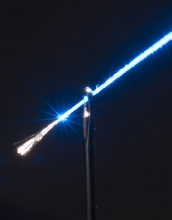News Release 06-045
New Process Builds Electronics Into Optical Fiber
Advance could lead to building a range of devices inside tiny light transmitters
March 16, 2006
This material is available primarily for archival purposes. Telephone numbers or other contact information may be out of date; please see current contact information at media contacts.
Scientists from Pennsylvania State University and the University of Southampton in the United Kingdom have demonstrated a new way to combine microelectronics and optical fibers--a development that opens up potential applications in fields as diverse as medicine, computing and remote sensing.
As they explain in the March 17 edition of the journal Science, the researchers have discovered how to fashion a thin, flexible tube of ultra-clear glass--an optical fiber--that has a hollow core packed with microscopic wires made of a semiconductor such as germanium. The scientists then created solid-state electronic devices, including a transistor, inside the semiconductors.
"This advance is the basis for a technology that could build a large range of devices inside an optical fiber," says Penn State chemist John Badding, one of the lead authors of the report.
Indeed, he says, it could help meet one of the greatest challenges in modern information technology. How do you rapidly and efficiently exchange information between optical fibers, which have proved to be the ideal medium for transmitting data (in the form of light pulses), and solid-state microelectronic devices, which are by far the most effective tools for manipulating and processing the data? "If the signal never leaves the fiber, then it is faster, cheaper and more efficient," says Badding.
"This fusion of two separate technologies opens the possibility of true optoelectronic devices that do not require conversion between optical and electronic signals," says University of Southampton optoelectronics expert Pier Sazio, another lead author. "If you think of the fiber as a water main, this structure places the pumping station inside the pipe. The glass fiber provides the transmission and the semiconductor provides the function."
Support for this research came from the National Science Foundation; the NSF-funded Penn State Center for Nanoscale Science; the Penn State-Lehigh Center for Optical Technologies; the U.K. Engineering and Physical Sciences Research Council; and the Mexican Council for Science and Technology.
For more details, see the Penn State news release.
-NSF-
Media Contacts
M. Mitchell Waldrop, NSF, (703) 292-7752, email: mwaldrop@nsf.gov
David C. Evans, University of Southampton, 44-2380-593-139, email: dce@orc.soton.ac.uk
Barbara K. Kennedy, Pennsylvania State University, (814) 863-4682, email: science@psu.edu
Principal Investigators
Pier Sazio, University of Southampton, 44-7884-444-429, email: pjas@soton.ac.uk
John Badding, Pennsylvania State University, (814) 777-3054, email: jbadding@pearl.chem.psu.edu
The U.S. National Science Foundation propels the nation forward by advancing fundamental research in all fields of science and engineering. NSF supports research and people by providing facilities, instruments and funding to support their ingenuity and sustain the U.S. as a global leader in research and innovation. With a fiscal year 2023 budget of $9.5 billion, NSF funds reach all 50 states through grants to nearly 2,000 colleges, universities and institutions. Each year, NSF receives more than 40,000 competitive proposals and makes about 11,000 new awards. Those awards include support for cooperative research with industry, Arctic and Antarctic research and operations, and U.S. participation in international scientific efforts.
Connect with us online
NSF website: nsf.gov
NSF News: nsf.gov/news
For News Media: nsf.gov/news/newsroom
Statistics: nsf.gov/statistics/
Awards database: nsf.gov/awardsearch/
Follow us on social
Twitter: twitter.com/NSF
Facebook: facebook.com/US.NSF
Instagram: instagram.com/nsfgov

